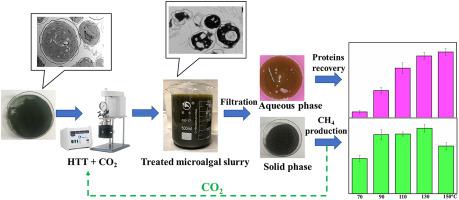Journal of Cleaner Production ( IF 9.7 ) Pub Date : 2020-08-05 , DOI: 10.1016/j.jclepro.2020.123563 Houkai Wu , Jiaming Li , Changjie Wang , Qiang Liao , Qian Fu , Zhidan Liu

|
Chlorella sp., as a kind of microalgae with high proteins content and rigid cell walls, is a potential material for proteins recovery as poultry feed supplement source. This study proposed an algal biorefinery paradigm for sequent production of proteins and biogas from microalgae Chlorella sp. via CO2 assisted hydrothermal treatment and anaerobic digestion. The CO2 could be sustainably refilled as being a bioproduct of biogas. As a widely-used environmentally benign hydrothermal catalyst, the addition of CO2 could reduce treatment temperature and CO2 is easily removed by depressurizing. Microalgal cells were more disrupted with rising temperature from 70°C to 150°C, which facilitated the recovery of proteins. The recovery of proteins increased from 6.32% to 69.81%. After proteins recovery, the C/N ratio of microalgal residues was significantly higher than the untreated Chlorella sp. The process of proteins recovery could relieve the hydrolysis limitation of cell walls but reduce organics remained in microalgal residues. Biomethane production from microalgal residues exhibited a similar rising trend to proteins recovery. The highest cumulative biomethane production of 194.63 mL/gVS was achieved for the group at 130°C, and the lowest value of 104.42 mL/gVS was obtained for the group at 70°C. Excess microalgal cells disruption and side reactions led to the poor biomethane performance for the group at 150°C, consistent with the decreased proteins recovery. During anaerobic digestion, the concentration of acetic acid distributed in a range of 0.05–0.44 g/L, which was dominant among total volatile fatty acids. The proteins as poultry feed supplement would be preferable to be considered as the main product, and the biomethane was considered as the side product. Carbon balance analysis revealed that most groups could basically meet the CO2 demand for HTT except the group at 150°C. 130°C was considered as the favorable treatment temperature level, leading to a proteins yield of 0.41 g/gVS and biomethane yield of 91.47 mL/gVS by Chlorella sp.
中文翻译:

从小球藻中分离生产蛋白质和沼气。通过CO 2辅助水热处理和厌氧消化
小球藻(Chlorella sp。)是一种蛋白质含量高,细胞壁坚硬的微藻,是家禽饲料补充剂中回收蛋白质的潜在材料。这项研究提出了一种藻类生物精炼范例,用于从微藻小球藻中依次生产蛋白质和沼气。通过CO 2辅助水热处理和厌氧消化。CO 2可以作为沼气的生物产物而被可持续地再填充。作为一种广泛使用的环境友好型水热催化剂,添加CO 2可以降低处理温度和CO 2。通过减压很容易去除。温度从70°C升高到150°C,微藻细胞受到的破坏更大,这有助于蛋白质的回收。蛋白质的回收率从6.32%增加到69.81%。蛋白质回收后,微藻残留物的C / N比明显高于未处理的小球藻sp。蛋白质回收过程可以减轻细胞壁的水解限制,但减少微藻残留物中残留的有机物。从微藻残渣生产生物甲烷显示出与蛋白质回收相似的上升趋势。在130°C时,该组的最高累积生物甲烷产量为194.63 mL / gVS,在70°C时,该组的最低累积生物甲烷产量为104.42 mL / gVS。过量的微藻细胞破坏和副反应导致该组在150°C的生物甲烷性能较差,这与蛋白质回收率下降相一致。在厌氧消化过程中,乙酸的浓度分布在0.05-0.44 g / L的范围内,在总挥发性脂肪酸中占主导地位。作为家禽饲料补充剂的蛋白质最好被视为主要产品,生物甲烷被视为副产品。碳平衡分析表明,大多数组基本上可以满足CO除在150°C的温度组外,HTT的需求为2。130℃被认为是有利的处理温度水平,导致小球藻的蛋白质产量为0.41g / gVS,生物甲烷产量为91.47mL / gVS 。











































 京公网安备 11010802027423号
京公网安备 11010802027423号